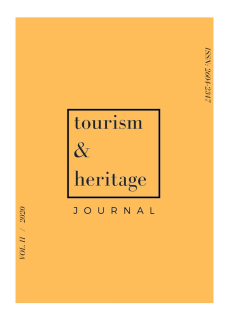The evaluation and analysis of digital tools in the archaeological site of Empúries, Catalonia
DOI:
https://doi.org/10.1344/THJ.2020.2.5Keywords:
Arqueología, evaluación, herramientas digitales, Patrimonio Cultural, Patrimonio DigitalAbstract
Within the scope of the evolution of technologies, there are more and more heritage and cultural spaces that include in their dissemination and mediation technological tools, specifically and significantly, those catalogued as digital tools. This study takes into account heritage spaces that have permanently included digital tools as mediation resources in archaeological spaces. To this end, the case of the archaeological site of Empúries, Catalonia, has been taken as an example, where an evaluation of these digital tools has been carried out based on their capacity to create and transmit knowledge to users, on the understanding of the material remains present in the site and on the satisfaction generated by these tools. This research is of an exploratory nature and has been carried out using a qualitative methodology. The aim is to establish to what extent the technological or digital tools (specifically, the audio guide and Virtual Reality) help to understand the material remains present in the archaeological site, and the extent to which the digital tools chosen in the mediation of the heritage encourage interaction between visitor and environment is analysed. The results show that it is not possible to say that digital tools significantly increase visitor satisfaction, since the average response of all visitors, regardless of the visit made, is positive.References
Angulo, F., Betanzo, M. J., & López, M. M. (2005). Viviendo los contenidos: una experiencia en el uso de tecnologías móviles en los procesos de Enseñanza y Aprendizaje. Quaderns Digitals, 37. http://hdl.handle.net/10498/16729
Arcos-Pumarola, J., Llonch-Molina, N., & Osácar Marzal, E. (2019). The concept of literary heritage: a definition through bibliographic review. Forum for World Literature Studies, 11(1), 97-120.
Asensio, M. [laCaixa]. (2012, Octubre 25). Marco conceptual de la evaluación en museos Mikel Asensio [Archivo de vídeo]. https://www.youtube.com/watch?v=wW4R99IMtw4
Comunitat de Práctica y Escola (COP) (2019). Guía para evaluar y orientar el diseño de las actividades educativas patrimoniales. Museus 2030. Quaderns. Departament de Cultura de la Generalitat de Catalunya.
Fischer, B. (2010). Rome Reborn: A Case Study in the Digital Reconstruction of Historic Cities. https://lisbon-pre-1755-earthquake.org/international-workshop-on-virtual-historiccities-reinventing-urban-research/
London Charter. (2009). Carta para la visualización computarizada del patrimonio cultural. King’s College London.
Milgram, P., & Kishino, F. (1994). A taxonomy of mixed reality visual displays. IEICE TRANSACTIONS on Information and Systems, 77(12), 1321-1329. http://citeseerx.ist.psu.edu/viewdoc/summary?doi=10.1.1.102.4646
Morgan, C. L. (2009). (Re)Building Çatalhöyük: Changing Virtual Reality in Archaeology. Archaeologies, 5(3), 468–487. doi: 10.1007/s11759-009-9113-0
Santacana, J. & Masriera, C. (2012). La arqueología reconstructiva y el factor didáctico. Ediciones Trea.
Santacana, J., Asensio, M., & Llonch, N. (2018). App, arqueologia and m-learning: Reconstruir, restituir, interpretar i avaluar App. Rafael Dalmau.
Santancana, J., Asensio, M., López, V., & Martínez, T. (coords.) (2018). La evaluación de las APPs en el Patrimonio Cultural. Ediciones Trea. SEAV.(2012). Principles of Seville – International Principles of Virtual Archaeology. Sociedad Española de Arqueología Virtual.
Vicent, N., Ibáñez-Etxeberria, A., & Asensio, M. (2015). Evaluation of heritage education technologybased programs. Virtual Archaeology Review, 6(13), 20-27. https://doi.org/10.4995/var.2015.4367
Vicent, N., Rivero, Mª P. & Torruella, M. F. (2015). Arqueología y tecnologías digitales en Educación Patrimonial. Educatio Siglo XXI, 33(1), 83-102. https://doi.org/10.6018/j/222511
Wang, D., Xiang, Z., & Fesenmaier, D. R. (2016). Smartphone use in everyday life and travel. Journal of travel research, 55(1), 52-63. https://doi.org/10.1177/0047287514535847
Downloads
Published
How to Cite
Issue
Section
License
Copyright (c) 2020 Itziar Calzado-Sánchez

This work is licensed under a Creative Commons Attribution 4.0 International License.
The authors who publish in this journal agree to the following terms:
- Authors retain copyright and grant the journal the right of first publication.
- Texts will be published under a Creative Commons Attribution License that allows others to share the work, provided they include an acknowledgement of the work’s authorship, its initial publication in this journal and the terms of the license.




